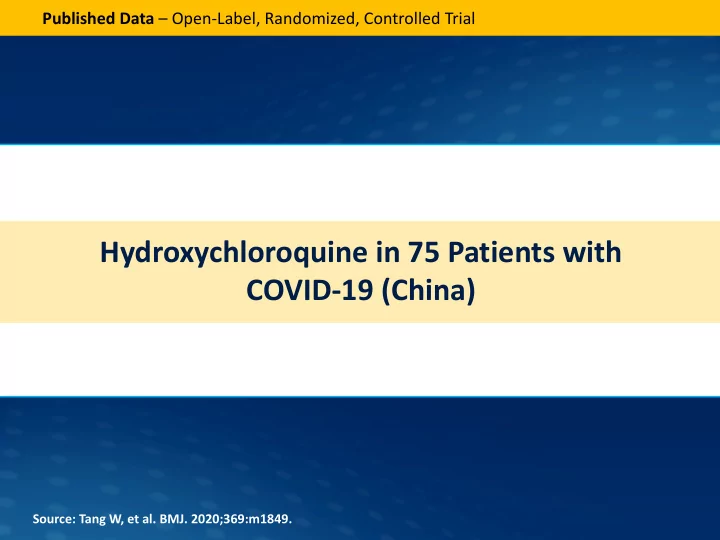

Published Data – Open-Label, Randomized, Controlled Trial Hydroxychloroquine in 75 Patients with COVID-19 (China) Source: Tang W, et al. BMJ. 2020;369:m1849.
Hydroxychloroquine + Standard of Care (SOC) vs. SOC Alone in Hospitalized Patients with COVID-19: Open Label RCT Study Design • Background : Multicenter, open-label, randomized, controlled trial of hydroxychloroquine plus standard of care versus standard of care alone in 150 patients at 16 government- designated COVID-19 treatment centers across China from February 11 – 29, 2020. • Primary Endpoint : Conversion to a negative SARS-CoV-2 RT-PCR by 28-days • Secondary endpoints (included): § Conversion to a negative SARS-CoV-2 RT-PCR at 4, 7, 10, 14, and 21 days § Improvement in clinical symptoms within 28 days § Change in C reactive protein and lymphocyte count within 28-days • Inclusion Criteria - 18 years of age or older - SARS-CoV-2 infection confirmed by RT-PCR - Able to take hydroxychloroquine orally • Exclusion Criteria: - Known allergy to hydroxychloroquine - Existing condition that could lead to severe adverse event with hydroxychloroquine use - Pregnancy and/or lactating mothers Source: Tang W, et al. BMJ. 2020;369:m1849.
Hydroxychloroquine + Standard of Care (SOC) vs. SOC Alone in Hospitalized Patients with COVID-19: Study Arms Arms and Interventions (Intention to Treat) Hydroxychloroquine 1,200 mg daily for 3 days, followed by 800 mg daily for 2 or 3 weeks* + standard of care (n = 75 ^ ) or Standard of care alone (n = 75 + ) Hydroxychloroquine was given for 2 weeks in patients with mild/moderate disease and • for 3 weeks in patients with severe disease. Authors did not define what constituted mild/moderate versus severe disease. ^ 6 patients did not receive any doses of hydroxychloroquine • + 1 patient received hydroxychloroquine • Source: Tang W, et al. BMJ. 2020;369:m1849.
Hydroxychloroquine + Standard of Care (SOC) vs. SOC Alone in Hospitalized Patients with COVID-19: Baseline Characteristics HCQ + SOC SOC Alone Baseline Characteristic* (n = 75) (n = 75) Age in years – mean (SD) 48.0 ± 14.1 44.1 ± 15.0 Male – no. (%) 42 (56) 40 (53) Days from disease onset to randomization (SD) 16.0 ± 9.9 17.1 ± 11.1 Medication prior to randomization – no. (%) 47 (63) 43 (57) Disease severity – no. (%) Mild 15 (20) 7 (9) Moderate 59 (79) 67 (89) Severe 1 (1) 1 (1) Coexisting conditions – no. (%) 28 (37.3) 17 (22.7) Diabetes 12 (16) 9 (12) Hypertension 6 (8) 3 (4) Source: Tang W, et al. BMJ. 2020;369:m1849.
Hydroxychloroquine + Standard of Care (SOC) vs. SOC Alone in Hospitalized Patients with COVID-19: Results Comparison of Patients (%) with Negative Nasopharyngeal PCR by Day 28 100 SARS-CoV-2 PCR Negative by 28 Days (%) 85.4 81.3 80 60 40 20 0 Hydroxychloroquine Standard of Care + Standard of Care Source: Tang W, et al. BMJ. 2020;369:m1849.
Hydroxychloroquine + Standard of Care (SOC) vs. SOC Alone in Hospitalized Patients with COVID-19: Results Median Time (Days) to Negative Nasopharyngeal PCR 10 8 8 7 Median Days (%) 6 4 2 0 Hydroxychloroquine Standard of Care + Standard of Care Source: Tang W, et al. BMJ. 2020;369:m1849.
Hydroxychloroquine + Standard of Care (SOC) vs. SOC Alone in Hospitalized Patients with COVID-19: Results • Median time to conversion to a negative SARS-CoV-2 RT-PCR did not differ between those who received HCQ + SOC vs. SOC alone. - HCQ + SOC: median 8 days - SOC alone: median 7 days - Hazard ratio: 0.846 (95% CI: 0.580 – 1.234, p=0.341) • There was no difference in the rate of conversion to a negative SARS-CoV-2 RT-PCR between groups at 4, 7, 10, 14, or 21 days. Abbreviations: HCQ = hydroxychloroquine; SOC = standard of care Source: Tang W, et al. BMJ. 2020;369:m1849.
Hydroxychloroquine + Standard of Care (SOC) vs. SOC Alone in Hospitalized Patients with COVID-19: Results • Overall rate of symptoms alleviation within 28-days did not differ between patients who received HCQ + SOC vs. SOC alone - HCQ + SOC: 59.9% (95% CI: 45% – 75.3%) - SOC alone: 66.6% (95% CI: 39.5% – 90.9%) • Median time to alleviation of clinical symptoms was similar across groups. - HCQ + SOC: 19 days - SOC alone: 21 days • In a post-hoc subgroups analysis, controlling for receipt of other antiviral agents, HCQ + SOC was associated with a higher likelihood of improvement in clinical symptoms when compared to SOC alone. • HCQ + SOC led to a more rapid decline in CRP and improvement in lymphopenia when compared to SOC alone, but overall improvement was similar by 28 days. • Adverse events occurred in 30% of the HCQ + SOC group in comparison to 8.8% of the SOC alone. Diarrhea was the most common adverse event reported in patients who received HCQ (10%). Source: Tang W, et al. BMJ. 2020;369:m1849.
Hydroxychloroquine + Standard of Care (SOC) vs. SOC Alone in Hospitalized Patients with COVID-19: Authors’ Conclusions Conclusions : “Administration of hydroxychloroquine did not result in a significantly higher probability of negative conversion than standard of care alone in patients admitted to hospital with mainly persistent mild to moderate covid-19. Adverse events were higher in hydroxychloroquine recipients than in non-recipients..” Source: Tang W, et al. BMJ. 2020;369:m1849.
Recommend
More recommend